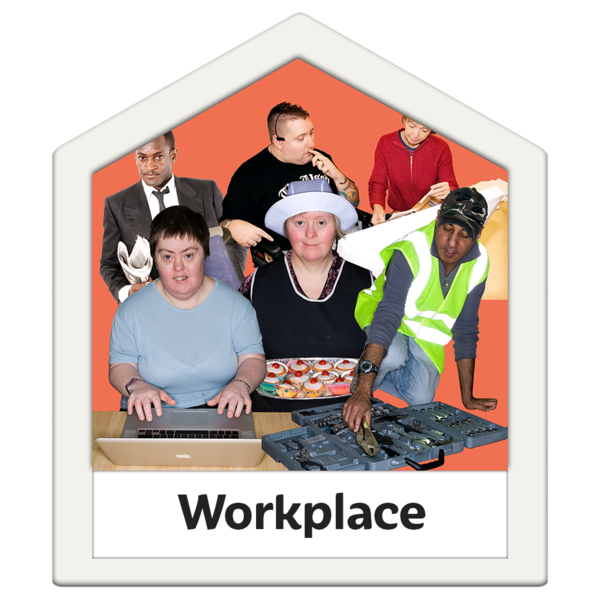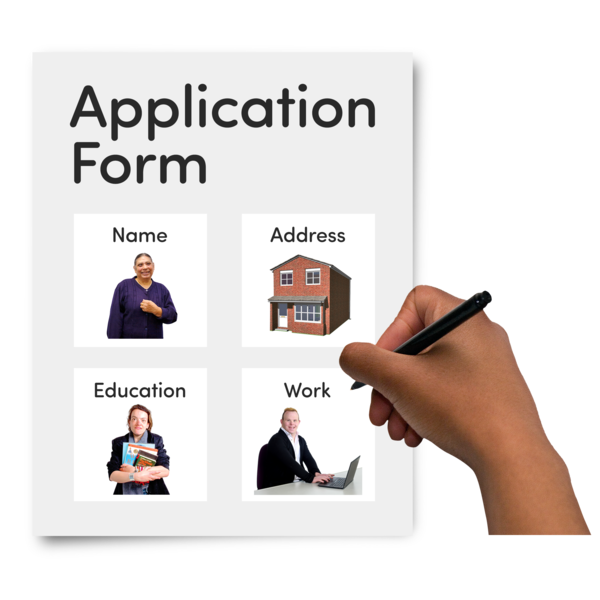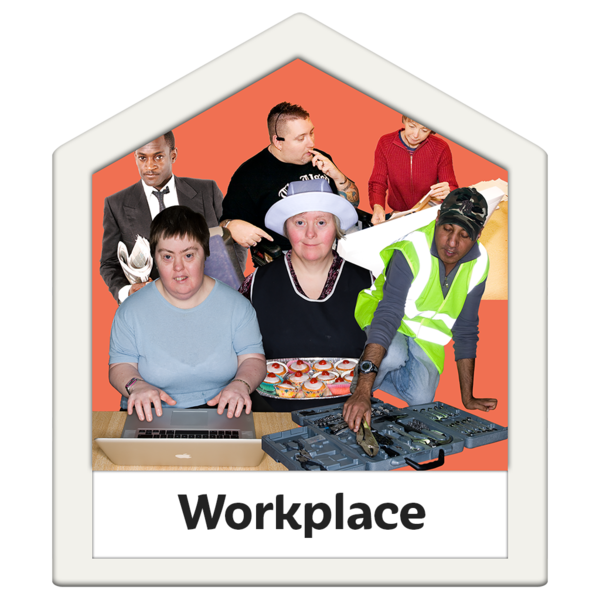Fact sheet 4: Making reasonable adjustments to recruitment processes and in the workplace
This fact sheet outlines practical steps employers can take to make their recruitment processes more inclusive and to support people with learning disabilities once they are in work. But remember that you can access help too! See Fact sheet 5: What support is available.
One of the greatest barriers for people with a
learning disability
 A learning disability is to do with the way someone's brain works. It makes it harder for someone to learn, understand or do things.
is the recruitment process, including the following factors:
A learning disability is to do with the way someone's brain works. It makes it harder for someone to learn, understand or do things.
is the recruitment process, including the following factors:
- online-only applications
- formal interviews
- unrelated qualification requirements.
These factors inhibit access to jobs that people with a learning disability may be perfectly capable of doing. Very few people with a learning disability get through the initial recruitment stage unless you make some adjustments right from the start.
This fact sheet provides some tips about reasonable adjustments that can make a big difference to someone with a learning disability and your ability to recruit the right person.
Advertisements
If you are using advertisements to recruit, it is good practice to publicly welcome applications from disabled people. Make it clear that you can provide the vacancy information in an
accessible
 Accessible means something is easy for people to use or join in with. For example: Accessible writing means the writing is easy to read and understand.
format such as large print (which people with a learning disability will find easier to read) or with illustrations. You can ask your local Jobcentre Plus to display your advert and ask them to make sure that disabled people will see it. You can also mail your vacancy bulletins to your local Mencap
service
Accessible means something is easy for people to use or join in with. For example: Accessible writing means the writing is easy to read and understand.
format such as large print (which people with a learning disability will find easier to read) or with illustrations. You can ask your local Jobcentre Plus to display your advert and ask them to make sure that disabled people will see it. You can also mail your vacancy bulletins to your local Mencap
service
 A service gives people what they need, like healthcare services that help people when they are ill, and support services that give people support.
.
A service gives people what they need, like healthcare services that help people when they are ill, and support services that give people support.
.
Recruitment days
Jobcentre Plus or your local supported
employment
 Employment means having a job.
agency could also help you to organise a recruitment day where you can welcome people with a learning disability or any disability to come and find out about working for your
organisation
Employment means having a job.
agency could also help you to organise a recruitment day where you can welcome people with a learning disability or any disability to come and find out about working for your
organisation
 An organisation are a group of people who work together.
. Your staff should receive disability awareness training before any event you organise. Mencap or other supported employment agencies can provide this.
An organisation are a group of people who work together.
. Your staff should receive disability awareness training before any event you organise. Mencap or other supported employment agencies can provide this.
If you are a Disability Confident Employer, remember that your organisation is more likely to attract applicants with a learning disability if they see the Disability Confident logo on the advert.
Application forms
Many companies have an online-only application process, which creates an unnecessary barrier for many people with a learning disability. Furthermore, many application forms are lengthy and complicated which compounds the challenge. A reasonable adjustment would be to allow paper applications or the submission of a
CV
 A CV is also called a Curriculum Vitae. It is a document with information about: your skills, your qualifications and any jobs or volunteering you have done. You may have to send a CV when you try to get a job.
as an alternative. Sometimes , a person with a learning disability may need support to complete an
application form
A CV is also called a Curriculum Vitae. It is a document with information about: your skills, your qualifications and any jobs or volunteering you have done. You may have to send a CV when you try to get a job.
as an alternative. Sometimes , a person with a learning disability may need support to complete an
application form
 An application form is a form you have to fill in to try to get something.
. There should be an option to declare that support has been provided.
An application form is a form you have to fill in to try to get something.
. There should be an option to declare that support has been provided.
Selection
When selecting candidates for a job, do not rule out candidates who have little or no paid
work experience
 Work experience is when you try out a job to help you learn new skills.
. Many candidates with a learning disability may not have had the chance of paid work before but will have unpaid work experience.
Work experience is when you try out a job to help you learn new skills.
. Many candidates with a learning disability may not have had the chance of paid work before but will have unpaid work experience.
Disability discrimination exception
Under the
Equality
 Equality is when everyone is treated fairly.
Act, you can create and reserve roles specifically for disabled people. The independent employment advice and conciliation service, Acas, have
guidance
Equality is when everyone is treated fairly.
Act, you can create and reserve roles specifically for disabled people. The independent employment advice and conciliation service, Acas, have
guidance
 Guidance means being given clear instructions to be able to do something well.
for employers on applying the
law
Guidance means being given clear instructions to be able to do something well.
for employers on applying the
law
 Laws are the rules that everyone in the country has to follow. If you don't follow the rules you can get in trouble with the police.
: ‘You can specifically advertise for and recruit a disabled person without the risk of disability
discrimination
Laws are the rules that everyone in the country has to follow. If you don't follow the rules you can get in trouble with the police.
: ‘You can specifically advertise for and recruit a disabled person without the risk of disability
discrimination
 Discrimination is when someone is treated differently (usually in a bad way) because of things like their disability or their
religion
Discrimination is when someone is treated differently (usually in a bad way) because of things like their disability or their
religion
 Religion is to do with the things you believe about the world. For example you may believe there is a god or something else. Examples of religions are Christianity, Hinduism, Islam and Judaism.
.
. This can be a useful approach to help increase representation of disabled people in your workforce.’ Employers may be able to use this to hire more people with a learning disability. However, while you can create and reserve a role for a disabled person, you cannot discriminate between disabilities, meaning all disabled people should have equally weighted applications. You cannot treat people with a learning disability more favourably, unless you can evidence that there is either an occupational requirement for the post holder to have a learning disability or you are using positive action where another disabled candidate is otherwise of equal merit (1).
Religion is to do with the things you believe about the world. For example you may believe there is a god or something else. Examples of religions are Christianity, Hinduism, Islam and Judaism.
.
. This can be a useful approach to help increase representation of disabled people in your workforce.’ Employers may be able to use this to hire more people with a learning disability. However, while you can create and reserve a role for a disabled person, you cannot discriminate between disabilities, meaning all disabled people should have equally weighted applications. You cannot treat people with a learning disability more favourably, unless you can evidence that there is either an occupational requirement for the post holder to have a learning disability or you are using positive action where another disabled candidate is otherwise of equal merit (1).
Interviews
Formal interviews are daunting to most people. Interviews can be particularly difficult for a candidate with a learning disability because they often play to their weaknesses and give the candidate little or no opportunity to demonstrate their strengths. Interviews are an artificial environment in which candidates are often asked hypothetical questions. This puts a candidate with a learning disability at a substantial disadvantage. Arguably, an interview is an ineffective test of a person’s ability to do a job, especially if the job requires practical skills.
As a reasonable adjustment under the Equality Act, you could waive the interview process altogether. Instead, you could:
- Have a short, practical
assessment
 An assessment is a way of finding out what help a person needs. When you have an assessment, you might have to go to a meeting or fill in a form.
in the workplace in which the candidate is shown the skills that the job requires and is asked to demonstrate their capacity to do the task – you should encourage the candidate to bring a supporter along if they need one.
An assessment is a way of finding out what help a person needs. When you have an assessment, you might have to go to a meeting or fill in a form.
in the workplace in which the candidate is shown the skills that the job requires and is asked to demonstrate their capacity to do the task – you should encourage the candidate to bring a supporter along if they need one. - Offer a ‘work trial’ (also known as an ‘on the job’ or ‘working’ interview) of between one and eight weeks, depending on the person’s ability and the complexity of the role. A work trial is similar to a work experience placement, except a paid job is guaranteed if the trial is successful. During the work trial, the person learns the skills required for the job and proves their ability to their potential employer. This can be with the support of a job coach. Funding may be available through Access to Work and Access to Work Plus.
If you must hold an interview, make the following adjustments so that the process is more inclusive. You could:
- Encourage/allow the candidate to bring a job coach/supporter to the interview if they would benefit from having one. This can help people to feel more confident.
- Let the candidate know what to expect in advance. For example, they should know how many people they will be meeting, how many questions they will be asked, the types of questions and how long the interview is likely to last.
- Make the interview as informal as possible.
- Consider whether you need a panel or whether the number of people interviewing could be reduced
- Make sure the candidate and their supporter have time to prepare in advance, particularly if there is an aptitude test. Provide additional time to sit the test and allow more time for the interview.
- Use plain English and make sure the person is following you. It is fine to ask, “do you understand the question?” and to offer to rephrase it if necessary. Avoid hypothetical questions like, “what would you do if…?” and ask questions that relate to the person’s direct experience instead like “can you tell me what you did at the library?”
On the job
Once you have decided to employ someone with a learning disability, there may be other things that an employee with a learning disability may need to do the job. Some people with a learning disability might benefit from a job coach to help them learn the job. Others may benefit from a daily task list that clearly shows what they need to do. The best thing is to speak to your employee and ask them what they would find useful.
Job coach
The provision of a job coach is one of the most significant benefits to an employer during the recruitment process and at the onset of employment. A job coach is an individual who is employed to help people with disabilities learn and perform their work duties, usually using a technique called Training in Systematic Instruction (TSI). TSI involves breaking down tasks into small chunks so people can learn through repetition. A job coach may work with individuals one-on-one and/or in a small group. In addition to working on skills related to performing specific job tasks, a job coach also helps with interpersonal skills necessary in the workplace. If a person with a learning disability is in paid work, or on a Supported Internship programme, a job coach can be paid for through Access to Work and/or Access to Work Plus, so this support is available at little or no cost to the employer. For more information on how to apply for this support, please see Fact sheet 5: What support is available and Fact sheet 6: Financial support for workplace adjustments.
Job carving
One approach that often proves helpful in employing people with a learning disability is called ‘job-carving’. Instead of fitting a person into a rigid job description, it can be much more effective to identify different tasks that a person with a learning disability can do and ‘carve’ out a job from these different tasks.
For example, this might involve freeing up the receptionist from doing the mail distribution or the office
manager
 A manager is a boss at work. They tell you what you need to do and give you support if you need it.
from stuffing envelopes and data entry. Removing these tasks from another employee’s job frees up their time to concentrate on the more complex areas of their job role. All the tasks should be genuine business needs for the employer that the employee with a learning disability could usefully do.
A manager is a boss at work. They tell you what you need to do and give you support if you need it.
from stuffing envelopes and data entry. Removing these tasks from another employee’s job frees up their time to concentrate on the more complex areas of their job role. All the tasks should be genuine business needs for the employer that the employee with a learning disability could usefully do.
In an office or administrative setting, examples of tasks which could be carved out of existing jobs might include:
- data entry
- sending out pay slips/post
- compiling information packs
- handing out the post
- photocopying for large mail-outs
- putting labels onto envelopes
- filing
- answering the phone and taking messages.
Sources:
1 Acas (2023), Recruitment: hiring someone, available online: https://www.acas.org.uk/hiring-someone/using-protected-characteristics